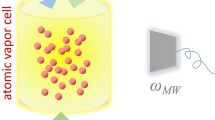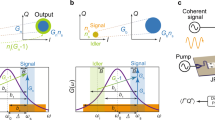Abstract
High-intensity multimode laser theory is used to derive the absorption coefficients for 1) a coherent light beam (probe) interacting with a possibly inhomogeneously broadened medium in the presence of an intense second corunning beam, and for 2) the sedibands of a weakly modulated light beam interacting with the medium. The general expressions are specialized to non-saturating probes and the short dipole-lifetime limit, yielding coherent pulsation-dip formulas. These are given for both homogeneous and inhomogeneous broadening and typically consist of simple power-broadened Lorentzians with widths equal to the smaller level-decay constant. The amplitude modulation case features pulsation dips twice as deep as the single-probe case, while the frequency modulation case exhibits no pulsation dip at all. Spectroscopic methods are discussed including the heterodyne advantage obtained with collinear light beams.
Similar content being viewed by others
References
T. Hänsch, P. Toschek: IEEE J. Quant. Electr. QE-4, 467 (1968)
R.G. Brewer, M.J. Kelly, A. Javan: Phys. Rev. Lett.23, 559 (1969)
C. Bordé: C. R. Acad. Sci. (Paris)271, 371 (1970)
P.W. Smith, T. Hänsch: Phys. Rev. Lett.26, 740 (1971)
T.W. Hänsch, M.D. Levenson, A.L. Schawlow, P. Toschek: Bull. Am. Phys. Soc.16, 310 (1971)
For a general review of saturation spectroscopy, seeLaser Spectroscopy, ed. by H. Walther. Topics in Applied Physics2 (Springer, Berlin, Heidelberg, New York 1976)
J. Hambenne, M. Sargent III: Phys. Rev. A13, 784 and 797 (1976)
M. Sargent III, P.E. Toschek: Appl. Phys.11 (October 1976)
M. Sargent III: Appl. Phys.9, 127 (1976)
M. Sargent III: to be published
E.V. Baklanov, V.P. Chebotaev: Zh. Eksp. Teor. Fiz.61, 922 (1971) (Sov. Phys. JETP34, 490 (1972))
S. Haroche, F. Hartmann: Phys. Rev. A6, 1280 (1972)
M. Sargent, M.O. Scully, W.E. Lamb, Jr.:Laser Physics (Addison-Wesley, Reading, Mass 1974)
C.V. Shank, S.E. Schwarz. Appl. Phys. Lett.13, 113 (1968)
J.L. Hall:Atomic Physics, Vol. 3 (Plenum Press, New York 1972), p. 615; R. Keil: to be published
S. Stenholm, W.E. Lamb, Jr.: Phys. Rev.181, 618 (1969)
B.J. Feldman, M.S. Feld: Phys. Rev. A1, 1375 (1970)
L.N. Menegozzi, W.E. Lamb, Jr.: Phys. Rev. A8, 2103 (1973)
K. Takata: Jap. J. Appl. Phys.11, 699 (1972)
Author information
Authors and Affiliations
Additional information
Work performed as a Humboldt awardee in Germany.
Work supported in part by the Space and Missiles Systems Organization, Los Angeles, California.
Work supported by the “Deutsche Forschungsgemeinschaft”.
Rights and permissions
About this article
Cite this article
Sargent, M., Toschek, P.E. & Danielmeyer, HG. Unidirectional saturation spectroscopy, I theory and short dipole lifetime limit. Appl. Phys. 11, 55–62 (1976). https://doi.org/10.1007/BF00895016
Received:
Issue Date:
DOI: https://doi.org/10.1007/BF00895016




